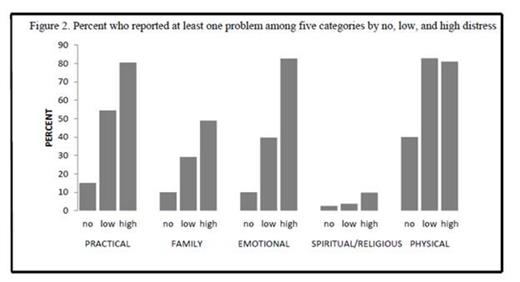Abstract
Background: Distress can affect a patient's ability to cope with and manage disease. Patients may feel uncomfortable initiating conversations about distress with their provider. Systematic screening for distress in patients with bleeding disorders may help identify distressed patients and guide treatment services planning.
Objectives: Describe prevalence of distress in adult patients with bleeding disorders and the specific problems, health characteristics, and behaviors most associated with distress in this population.
Methods: Patients who attended the Emory Comprehensive Bleeding Disorder Clinic for a regularly scheduled visit between January 1st, 2012 through February 28th, 2014 and who completed a distress screen, pain screen, and clinic questionnaire during the visit were evaluated cross-sectionally. Distress was measured by the National Comprehensive Cancer Network Distress Management Tool which allowed patients to rate recent distress on a 0-10 point scale and also asked patients to identify from a checklist whether any of 38 specific issues among 5 different categories were recently problematic. A distress rating of 5 or more was categorized as high distress, 1-4 as mild/moderate distress, and 0 as no distress. Pain was measured by the Brief Pain Inventory Short Form which asked patients to rate their various pain types on 0-10 point scales. Patients reported current behavioral and demographic information including employment status, alcohol, and tobacco use on the clinic questionnaire. Depressive symptoms were measured on a 0-6 point scale using the Patient Health Questionnaire-2 screening tool. Primary diagnosis, age, prophylaxis use, and HIV and HCV status were taken from medical records. Unadjusted logistic regression models to identify predictors of high distress were used. Adjusted logistic regression models that controlled for possible confounders were used to examine whether diagnosis and employment were associated with high distress. In the adjusted model examining employment, because depression and pain were collinear, we ran two models; one including depression and one including pain.
Results: Of the 168 patients who formed the cohort, most were male (69%) and most had hemophilia as the primary diagnosis (67%). Nearly three-quarters identified as White race with one-quarter Black or African-American. Average patient age was 36 years and ranged from 18 to 83 years. HCV and HIV prevalence in the cohort were 35% and 13%, respectively. High distress prevalence (distress rating ≥ 5) was 31.6% (Figure 1). Patients who reported at least one emotional concern from the problem checklist were more likely to report high distress (Figure 2). In unadjusted analyses, patients who were older, unemployed or disabled, required assistance in daily life activities, reported opioid use, used crutches, had higher depressive symptoms, exercised less, and who reported high pain levels were more likely to report high distress. Diagnosis, gender, race, alcohol consumption, tobacco use, prophylaxis use, and HIV and HCV status were not associated with high distress. Unemployment, disability, higher depression symptoms, and high pain were associated with high distress in multivariate models (Table 1).
Conclusions: Nearly one-third of patients with bleeding disorders reported high distress while an additional 40% reported mild/moderate distress. Further study is needed to determine if high distress impacts clinical outcomes of patients with bleeding disorders as has been demonstrated in other chronic disorders.
Multivariate analysis results
| . | Adjusted Odds Ratios for High Distress (95% CI) . | ||
|---|---|---|---|
| Predictor . | Model 1 (n=148) . | Model 2 (n=126) . | Model 3 (n=137) . |
| Diagnosis | |||
| Severe/moderate hemophilia | 1.0 | ||
| Mild hemophilia | 1.91 (0.53 6.85) | ||
| Other bleeding disorders | 1.02 (0.28 3.74) | ||
| Employment | |||
| Work full-time | 1.0 | 1.0 | |
| Student, part-time, retired, homemaker, other | 0.51 (0.14 1.86) | 0.29 (0.07 1.18) | |
| Unemployed | 6.15 (1.33 28.44) | 5.49 (1.09 27.82) | |
| Disabled | 3.41 (1.08 10.78) | 2.37 (0.64 8.87) | |
| Age | 1.02 (0.99 1.05) | 1.02 (0.99 1.05) | 1.02 (0.99 1.06) |
| Pain Score | |||
| 0 (no pain) | 1.0 | ||
| 1-4 (low pain) | 1.12 (0.34 3.73) | ||
| 5-10 (high pain) | 4.85 (1.29 18.33) | ||
| Depression score | 2.61 (1.78 3.83) | 2.29 (1.52 3.45) | |
| . | Adjusted Odds Ratios for High Distress (95% CI) . | ||
|---|---|---|---|
| Predictor . | Model 1 (n=148) . | Model 2 (n=126) . | Model 3 (n=137) . |
| Diagnosis | |||
| Severe/moderate hemophilia | 1.0 | ||
| Mild hemophilia | 1.91 (0.53 6.85) | ||
| Other bleeding disorders | 1.02 (0.28 3.74) | ||
| Employment | |||
| Work full-time | 1.0 | 1.0 | |
| Student, part-time, retired, homemaker, other | 0.51 (0.14 1.86) | 0.29 (0.07 1.18) | |
| Unemployed | 6.15 (1.33 28.44) | 5.49 (1.09 27.82) | |
| Disabled | 3.41 (1.08 10.78) | 2.37 (0.64 8.87) | |
| Age | 1.02 (0.99 1.05) | 1.02 (0.99 1.05) | 1.02 (0.99 1.06) |
| Pain Score | |||
| 0 (no pain) | 1.0 | ||
| 1-4 (low pain) | 1.12 (0.34 3.73) | ||
| 5-10 (high pain) | 4.85 (1.29 18.33) | ||
| Depression score | 2.61 (1.78 3.83) | 2.29 (1.52 3.45) | |
All models also adjusted for race and HIV/HCV positivity
No relevant conflicts of interest to declare.
Author notes
Asterisk with author names denotes non-ASH members.



This feature is available to Subscribers Only
Sign In or Create an Account Close Modal